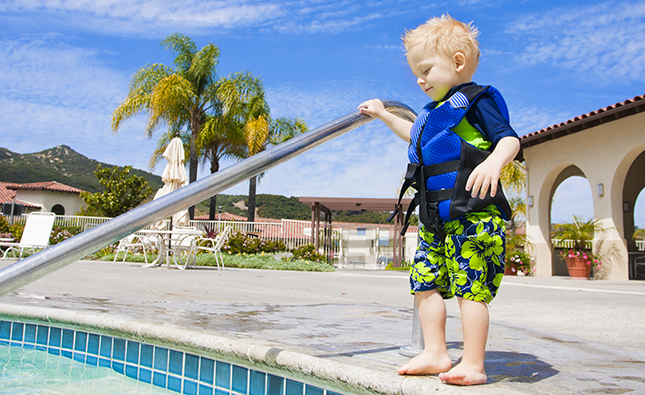By communicating these pool tips effectively as well as using common sense, your backyard pool can be a safe and pleasurable experience for children as well as adults.
- Check local ordinances and codes for safety requirements.
- Use non-slip materials on the pool deck, diving board and ladders.
- The steps of the pool ladder should be at least three inches wide, and the ladder should have handrails on both sides small enough for a child to grasp. There should be a ladder at both ends of the pool.
- Electrical equipment should be installed by a licensed electrician in accordance with local safety codes.
- Check with a professional pool contractor to be sure the depth is sufficient for a diving board or slide. Always put a slide in a deep area of the pool– never in shallow water.
- There should be a fence at least six feet high around all sides of the pool with a locked gate to keep children out when there is no supervision and the fence should be constructed so it is difficult to climb. Lawn furniture, trees and shrubs should not be close enough to provide an easy boost over the fence. Avoid using a side of the house in place of fencing to keep toddlers or pets from wandering into the pool area through an open door or window.
- Mark water depths conspicuously. Use a safety float line where the bottom slope deepens.
- Above-ground pools: Install sturdy guard rails around the pool deck. Look for rolled rims on the metal shell to be sure the rims do not present a sharp cutting edge if someone falls. The access ladder to the deck should be sturdy and without protruding bolts or other sharp edges. The access ladder should swing up to prevent children from unauthorized entry or should be easily removable for secure storage away from the pool area.
- Check the pool and equipment periodically for cleanliness and good maintenance. Cover all sharp edges and protruding bolts; repair rickety or broken ladders and railings. Replace non-slip materials when they wear out.
- Teach children to float or swim as soon as possible.
- Always provide competent adult supervision when the pool is in use.
- No one should ever swim alone.
- Caution children against showing off and playing rough and explain the dangers of running and diving recklessly.
- Never push others into the pool.
- When using water slides, always go feet first.
- Before diving or sliding, check to be sure that other swimmers are out of the way.
- Keep rescue devices and first aid supplies near the pool.
- Teach children what to do in case of emergency. An alarm bell that could summon help would be a good idea.
- Keep electrical appliances such as radios out of the pool area because of the hazard of electrical shock.
- Never swim after drinking alcoholic beverages, eating, or taking medications.


Comments are closed.